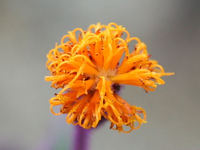Flower EncyclopediaENTER THE WORLD OF FLOWERS |
Other News
Gynura
Category: Decorative flowering
25 Jul : 09:51
To view pictures click on them




 Origin: Eastern Africa, Madagascar, East and South Asia
Origin: Eastern Africa, Madagascar, East and South AsiaFamily: Apiaceae - Compositae
inurata is a fast growing grass. The leaves and stems and are covered with purple hairs. Spring blooms with small, resembling dandelion petals. They must be removed, yet at the stage of buds because they smell bad. From time to time must squeeze stems to diverge.
The plant is not capricious. Suitable place is east or west window. Looks good in hanging baskets. The fresh air is reflected well. It is appropriate for hidrokultura.
Stems and leaves of ginurata are tightly covered with short hairs yarkolilavi. Tsavti with yellow flowers that emit an unpleasant odor, so that flower buds are cut off before they blossom.
In nature are found around 100 species ginuri, but indoor plants are given distribution only 2 types:
Gynura aurantiaca - herbaceous plant with a standing, well-branched stalks. Reaches a height of 50 - 90 cm consecutive leaves are arranged in ovoid-shaped with a serrated edge, to 15 cm long stems and leaves are covered with small hairs with violet flowers and bright light of the whole plant looks like violet. Blooms with small, gathered in clusters - baskets with orange.
Gynura sarmentosa - this plant is very similar to previous species, but less - reached a height of not more than 60 cm Its leaves are also smaller - up to 7 cm long.
Gynura scandens - with rough serrated leaves.
Light: Very bright, indirect sunlight. If the light is not sufficient, especially winter stems are reimbursed, the leaves are dark green, new leaves are smaller.
Temperature: Summer - moderate temperatures, the winter - to - 15o - 18o C
Irrigation: summer - plenty, winter - temperate
Sprinkling: NO!
High air humidity!
Fertilizing: Spring, Summer - 2 weeks
Replanting: Annual - spring. Good plant to be repeated 2 - 3 years because the lower leaves fall off and branches are bare.
Soil: 1 part clay, turf, Part 1 leaflet, 1 part topsoil, 1 part peat and 1 / 2 part coarse river sand
Propagation: cuttings, about 10 cm long - in water - spring or autumn
Hazards:
• drafts;
• Temperatures higher than 15o - 18o C in winter;
• The leaves are not wet!
Pests:
• aphids;
• Pamukliyki.
Ginurata Provide fresh air, but beware of the course. The temperature should not be uploaded over 18 * C, because the plant loses its most blasaka leaves wilt.
Category: Decorative flowering
Comments are turned off for this item0
| gynura aurantiaca compositae |
You must be logged in to make comments on this site - please log in, or if you are not registered click here to signup























































